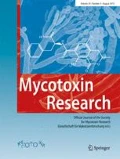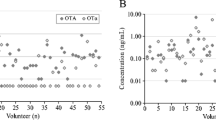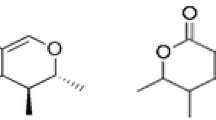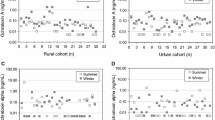Abstract
Ochratoxin A (OTA) and citrinin (CIT) are nephrotoxic mycotoxins, found in various foodstuffs and in animal feed, and may cause adverse effects on animal and human health. Previous biomonitoring data indicate a frequent co-exposure of Bangladeshi adults to these mycotoxins. However, since such data are not yet available for young children, a vulnerable part of the population, we conducted this study to assess their exposure to OTA and CIT and compare it with that of adults in Bangladesh. In total, 154 urine samples were collected from infants and children in Rajshahi (n = 88) and Dhaka (n = 66) district of Bangladesh. OTA, CIT, and their metabolites were analyzed by a sensitive HPLC–FLD or LC–MS/MS method, respectively. Overall, OTA and CIT biomarkers were detectable in 72.7% and 54.9% of urines, respectively. The mean OTA and OTα levels in urines were higher in children (0.13 ng/mL and 0.28 ng/mL, respectively) than in infants (0.08 ng/mL and 0.05 ng/mL, respectively). Regarding region, the mean level of OTA was higher in samples from Rajshahi district (0.13 ng/mL) than from Dhaka district (0.09 ng/mL), while the mean OTα level was 2-fold higher in the Dhaka. The total CIT biomarker concentration was significantly higher in children (2.16 ng/mL) than in infant (0.70 ng/mL) urines (p < 0.05), and the mean concentration of HO-CIT was about 6-fold higher than that of parent compound CIT. A provisional daily intake for CIT was calculated and exceeded a preliminary value set by EFSA (0.2 μg/kg bw) in 23.3% and 11.9% of children and infants, respectively. OTA and CIT biomarker concentrations in the young children cohorts are higher than those found in Bangladeshi adults in summer, but lower than in winter season. The new results indicate frequent co-exposure to nephrotoxic mycotoxins that varies between the cohorts and regions in Bangladesh.

Similar content being viewed by others
References
Ali N (2018) Co-occurrence of citrinin and ochratoxin A in rice in Asia and its implications for human health. J Sci Food Agric 98:2055–2059. https://doi.org/10.1002/jsfa.8667
Ali N, Degen GH (2019) Citrinin biomarkers: a review of recent data and application to human exposure assessment. Arch Toxicol 93:3057–3066. https://doi.org/10.1007/s00204-019-02570-y
Ali N, Blaszkewicz M, Manirujjaman M, Perveen R, Nahid AA, Mahmood S, Rahman M, Hossain K, Degen GH (2014) Biomonitoring of ochratoxin A in blood plasma and exposure assessment of adult students in Bangladesh. Mol Nutr Food Res 58:2219–2225. https://doi.org/10.1002/mnfr.201400403
Ali N, Blaszkewicz M, Degen GH (2015a) Occurrence of the mycotoxin citrinin and its metabolite dihydrocitrinone in urines of German adults. Arch Toxicol 89:573–578. https://doi.org/10.1007/s00204-014-1363-y
Ali N, Blaszkewicz M, Mohanto NC, Rahman M, Alim A, Hossain K, Degen GH (2015b) First results on citrinin biomarkers in urines from rural and urban cohorts in Bangladesh. Mycotoxin Res 31:9–16. https://doi.org/10.1007/s12550-014-0217-z
Ali N, Blaszkewicz M, Alim A, Hossain K, Degen GH (2016a) Urinary biomarkers of ochratoxin A and citrinin exposure in two Bangladeshi cohorts: follow-up study on regional and seasonal influences. Arch Toxicol 90:2683–2697. https://doi.org/10.1007/s00204-015-1654-y
Ali N, Blaszkewicz M, Manirujjaman M, Degen GH (2016b) Biomonitoring of concurrent exposure to ochratoxin A and citrinin in pregnant women in Bangladesh. Mycotoxin Research 32:163–172. https://doi.org/10.1007/s12550-016-0251-0
Ali N, Blaszkewicz M, Hossain K, Degen GH (2017a) Determination of aflatoxin M 1 in urine samples indicates frequent dietary exposure to aflatoxin B1 in the Bangladeshi population. Int J Hyg Environ Health 220:271–281. https://doi.org/10.1016/j.ijheh.2016.11.002
Ali N, Muñoz K, Degen GH (2017b) Ochratoxin A and its metabolites in urines of German adults—an assessment of variables in biomarker analysis. Toxicol Lett 275:19–26. https://doi.org/10.1016/j.toxlet.2017.04.013
Ali N, Hossain K, Degen GH (2018) Blood plasma biomarkers of citrinin and ochratoxin a exposure in young adults in Bangladesh. Mycotoxin Res 34:59–67
Al-Jaal BA, Jaganjac M, Barcaru A et al (2019) Aflatoxin, fumonisin, ochratoxin, zearalenone and deoxynivalenol biomarkers in human biological fluids: a systematic literature review, 2001-2018. Food Chem Toxicol 129:211–228. https://doi.org/10.1016/j.fct.2019.04.047
Blaszkewicz M, Liesenhoff-Henze K (2012) Creatinine in urine [biomonitoring methods, 2010]. In: Deutsche Forschungsgemeinschaft, Commission for the Investigation of Health Hazards of Chemical Compounds in the Work Area (eds) The MAK-collection for occupational health and safety. Wiley-VCH Verlag GmbH & Co. KGaA, Weinheim, pp 169–184
Blaszkewicz M, Munoz K, Degen GH (2013) Methods for analysis of citrinin in human blood and urine. Arch Toxicol 87:1087–1094
Castegnaro M, Canadas D, Vrabcheva T, Petkova-Bocharova T, Chernozemsky IN, Pfohl-Leszkowicz A (2006) Balkan endemic nephropathy: role of ochratoxins a through biomarkers. Mol Nutr Food Res 50:519–529
Degen GH (2016) Are we ready to estimate daily ochratoxin A intake based on urinary concentration? Environ Int 97:254–255
Degen GH, Ali N, Gundert-Remy U (2018) Preliminary data on citrinin kinetics in humans and their use to estimate citrinin exposure based on biomarkers. Toxicol Lett 282:43–48. https://doi.org/10.1016/j.toxlet.2017.10.006
Duarte SC, Pena A, Lino CM (2011) Human ochratoxin A biomarkers—from exposure to effect. Crit Rev Toxicol 41:187–212
Ediage EN, Di Mavungu JD, Song S et al (2013) Multimycotoxin analysis in urines to assess infant exposure: a case study in Cameroon. Environ Int 57:50–59
EFSA (2006) Opinion of the scientific panel on contaminants in the food chain [CONTAM] related to ochratoxin A in food. EFSA J 4:1–56 available from: https://www.efsa.europa.eu/en/efsajournal/pub/365
EFSA (2012) Scientific opinion on the risks for public and animal health related to the presence of citrinin in food and feed. EFSA J 10:2605
EFSA (2020) Scientific opinion on the risks to public health related to the presence of ochratoxin A in food. EFSA J 18(5):6113. https://doi.org/10.2903/j.efsa.2020.6113. Available from https://www.efsa.europa.eu/de/efsajournal/pub/6113
Ezekiel CN, Warth B, Ogara IM, Abia WA, Ezekiel VC, Atehnkeng J, Sulyok M, Turner PC, Tayo GO, Krska R, Bandyopadhyay R (2014) Mycotoxin exposure in rural residents in northern Nigeria: a pilot study using multi-urinary biomarkers. Environ Int 66:138–145. https://doi.org/10.1016/j.envint.2014.02.003
Flajs D, Peraica M (2009) Toxicological properties of citrinin. Arh Hig Rada Toksikol 60:457–464. https://doi.org/10.2478/10004-1254-60-2009-1992
Frisvad JC, Thrane U, Samson RA, Pitt JI (2006) Important mycotoxins and the fungi which produce them, Advances in food mycology. Springer, pp 3–31
Geisen R, Schmidt-Heydt M, Touhami N, Himmelsbach A (2018) New aspects of ochratoxin A and citrinin biosynthesis in Penicillium. Curr Opin Food Sci 23:23–31
Gerding J, Ali N, Schwartzbord J, Cramer B, Brown DL, Degen GH, Humpf HU (2015) A comparative study of the human urinary mycotoxin excretion patterns in Bangladesh, Germany, and Haiti using a rapid and sensitive LC-MS/MS approach. Mycotoxin Res 31:127–136. https://doi.org/10.1007/s12550-015-0223-9
Gong YY, Shirima CP, Srey C, Kimanya ME, Routledge MN (2015) Deoxynivalenol and fumonisin exposure in children and adults in a family study in rural Tanzania. World Mycotoxin J 8:553–560. https://doi.org/10.3920/WMJ2015.1878
Heyndrickx E, Sioen I, Huybrechts B, Callebaut A, de Henauw S, de Saeger S (2015) Human biomonitoring of multiple mycotoxins in the Belgian population: results of the BIOMYCO study. Environ Int 84:82–89
IARC (1986) Citrinin: some naturally occurring and synthetic food components, furocoumarins and ultraviolet radiation. IARC Monogr Eval Carcinog Risk Chem Hum 40:67
IARC (1993) Some naturally occurring substances: heterocyclic aromatic amines and mycotoxins. IARC Monogr Eval Carcinog Risk Chem Hum 56:397–444
Jonsyn-Ellis FE (2001) Seasonal variation in exposure frequency and concentration levels of aflatoxins and ochratoxins in urine samples of boys and girls. Mycopathologia 152:35–40
Lombard MJ (2014) Mycotoxin exposure and infant and young child growth in Africa: what do we know? Ann Nutr Metab 64:42–52. https://doi.org/10.1159/000365126
Märtlbauer E, Usleber E, Dietrich R, Schneider E (2009) Ochratoxin A in human blood serum–retrospective long-term data. Mycotoxin Res 25:175–186
Muñoz K, Blaszkewicz M, Degen GH (2010) Simultaneous analysis of ochratoxin A and its major metabolite ochratoxin alpha in plasma and urine for an advanced biomonitoring of the mycotoxin. J Chromatogr B 878:2623–2629
Ostry V, Malir F, Ruprich J (2013) Producers and important dietary sources of ochratoxin A and citrinin. Toxins 5:1574–1586
Peraica M, Domijan A-M, Miletić-Medved M, Fuchs R (2008) The involvement of mycotoxins in the development of endemic nephropathy. Wien Klin Wochenschr 120:402
Pfohl-Leszkowicz A (2009) Ochratoxin A and aristolochic acid involvement in nephropathies and associated urothelial tract tumours. Arhiv Za Higijenu Rada I Toksikologiju 60:465–482
Sarkanj B, Ezekiel C, Turner PC et al (2018) Ultra-sensitive, stable isotope assisted quantification of multiple urinary mycotoxin exposure biomarkers. Anal Chim Acta 1019:84–92
Shephard GS, Burger H-M, Gambacorta L, Gong YY, Krska R, Rheeder JP, Solfrizzo M, Srey C, Sulyok M, Visconti A, Warth B, van der Westhuizen L (2013) Multiple mycotoxin exposure determined by urinary biomarkers in rural subsistence farmers in the former Transkei, South Africa. Food Chem Toxicol 62:217–225
Sherif SO, Salama EE, Abdel-Wahhab MA (2009) Mycotoxins and child health: the need for health risk assessment. Int J Hyg Environ Health 212:347–368
Silva LJG, Macedo L, Pereira AMPT, Duarte S, Lino CM, Pena A (2020) Ochratoxin A and Portuguese children: urine biomonitoring, intake estimation and risk assessment. Food Chem Toxicol 135:110883. https://doi.org/10.1016/j.fct.2019.110883
Solfrizzo M, Gambacorta L, Visconti A (2014) Assessment of multi-mycotoxin exposure in southern Italy by urinary multi-biomarker determination. Toxins 6:523–538
Studer-Rohr I, Schlatter J, Dietrich DR (2000) Kinetic parameters and intraindividual fluctuations of ochratoxin A plasma levels in humans. Arch Toxicol 74:499–510
Wang X, Liang J, Cao P, Zhou S, Wu A, Gao P, Xu H, Liu Z, Gong Y (2019) Biomonitoring study of deoxynivalenol exposure in Chinese inhabitants. IJERPH 16:2169. https://doi.org/10.3390/ijerph16122169
Acknowledgments
The authors wish to thank I. Glaeser, M. Porta, and B. Aust for excellent technical assistance. We thank also all caretakers of urine donors who participated in the study.
Funding
This work was supported by a DAAD scholarship to Nurshad Ali.
Author information
Authors and Affiliations
Corresponding author
Ethics declarations
Conflict of interest
The authors declare that they have no conflict of interest.
Additional information
Publisher’s note
Springer Nature remains neutral with regard to jurisdictional claims in published maps and institutional affiliations.
Electronic supplementary material
ESM 1
(DOCX 13 kb)
Rights and permissions
About this article
Cite this article
Ali, N., Degen, G.H. Biological monitoring for ochratoxin A and citrinin and their metabolites in urine samples of infants and children in Bangladesh. Mycotoxin Res 36, 409–417 (2020). https://doi.org/10.1007/s12550-020-00407-7
Received:
Revised:
Accepted:
Published:
Issue Date:
DOI: https://doi.org/10.1007/s12550-020-00407-7




